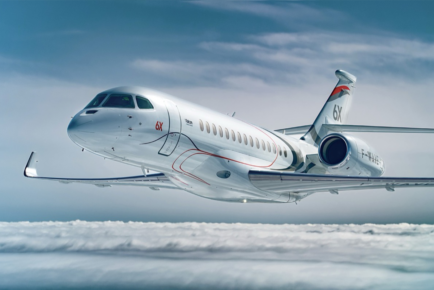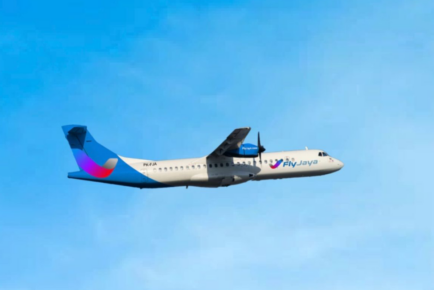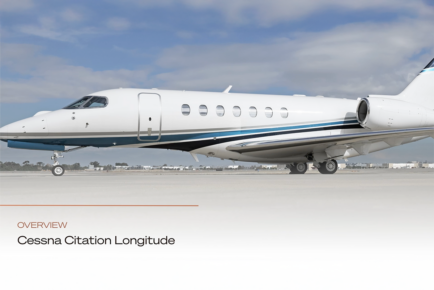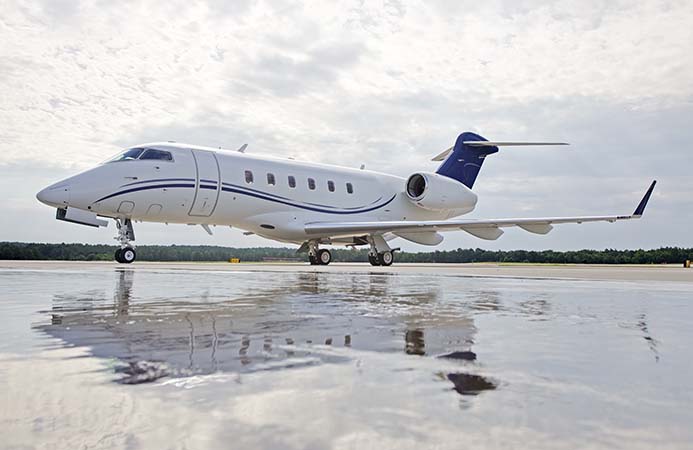
Overview including differentiating features from other aircraft in its category
The Challenger 300 is a mid-size business jet. It offers transcontinental range and long-range cruise speed in a typical eight-passenger cabin.
The cabin of the Challenger 300 fits eight or nine passengers in a double-club configuration (three seats can be swapped out for a 3-person divan, if desired). All of the passenger seats are fully adjustable and have fold-out tables and individual AC power plugs. Two-zone air conditioning keeps both the pilots and the passengers comfortable, and low-heat LED overhead lights (with a 10,000 hour life) give the cabin an open feel. The 106 cubic feet of baggage (750 pounds) stored in an exterior compartment is accessible in-flight through the fully enclosed lavatory. A forward luggage closet can be added as well.
As of January 2014, the Challenger 300 market is comprised of 67% pre-owned. The percentage for sale is 5.6% with 84% under an exclusive broker agreement and average days on the market are 241 days.
Brief History
The project was launched at the Paris Air Show on July 13, 1999, at which time it was called the Bombardier Continental. It was a “clean sheet” design, assembled in Bombardier’s Learjet plant at Wichita Mid-Continent airport, Kansas. The jet was renamed in September 2002 after much debate about which category (Learjet, Challenger, or Global) the new aircraft fit into. FAA type certification was received in June 2003, with entry into corporate service in January 2004.
Worldwide Appeal
Of the 429 Challenger 300 aircraft in operation by continent, North America has the largest percentage at 73%, followed by Europe at 16% for a combined total of 89%. Also, 37% of the 429 Challenger 300 jets in operation today are in fleet ownership with the largest fleet operator (Flexjet) having 28 aircraft. Interestingly, 14% of the Challenger 300 jets are leased.
Highlights
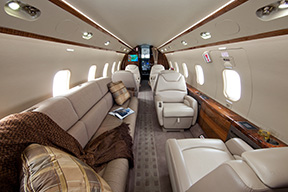 Performance
Performance
The Challenger 300 is powered by two Honeywell HTF 7000 engines each offering 6,826 pounds of thrust. The Challenger 300 uses 266 gallons per hour (GPH). The range of the Challenger 300 is 3,250 nm operating under NBAA IFR 4 passengers with available fuel.
Interior
The cabin volume for the Challenger 300 is 860 cubic feet. Typical configuration features 8 passenger and 2 crew seats.
Design
The Challenger 300 Maximum Take-Off Weight (MTOW) is 38,850 pounds (17,622 kg) with a maximum range of 3,310 nm.
Speed
| Maximum Cruise Speed: | 470 kts | 870 km/h | ||||||
| Long-range Speed: | 459 kts | 850 km/h |
Airfield Performance
| Takeoff distance: | 4,810 ft (1,466 m) | (SL, ISA, MTOW) | ||||||
| Landing distance: | 2,290 ft (698 m) | (SL, ISA, MLW) |
Operating Altitude
| Maximum operating altitude: | 45,000 ft (13,716 m) |
Noise Level (EPNdB)
| Takeoff: | 75.5 | Approach: | 89.6 | Lateral: | 87.6 |
|---|
Weights
| A. | Maximum ramp weight: | 39,000 lb (17,690 kg) | ||||||||
| B. | Maximum takeoff weight: | 38,850 lb (17,622 kg) | ||||||||
| C. | Maximum landing weight: | 33,750 lb (15,309 kg) | ||||||||
| D. | Maximum zero fuel weight: | 27,200 lb (12,338 kg) | ||||||||
| E. | Standard basic operating weight: | 23,850 lb (10,818 kg) |
Avionics
Rockwell Collins Pro Line 21
Resources
Click Here to view the online range map. To receive a more detailed custom range report including detailed aircraft comparisons, contact us at +1 919 941 8400 or [email protected].
Click Here to view Challenger 300 aircraft for sale by Jetcraft.
SIGN UP FOR OUR MONTHLY JETSTREAM RECAP
Don't miss future Jetstream articles. Sign up for our Jetcraft News mailing list to receive a monthly eblast with links to our latest articles. Click to join the 1,800+ subscribers on our mailing list.



